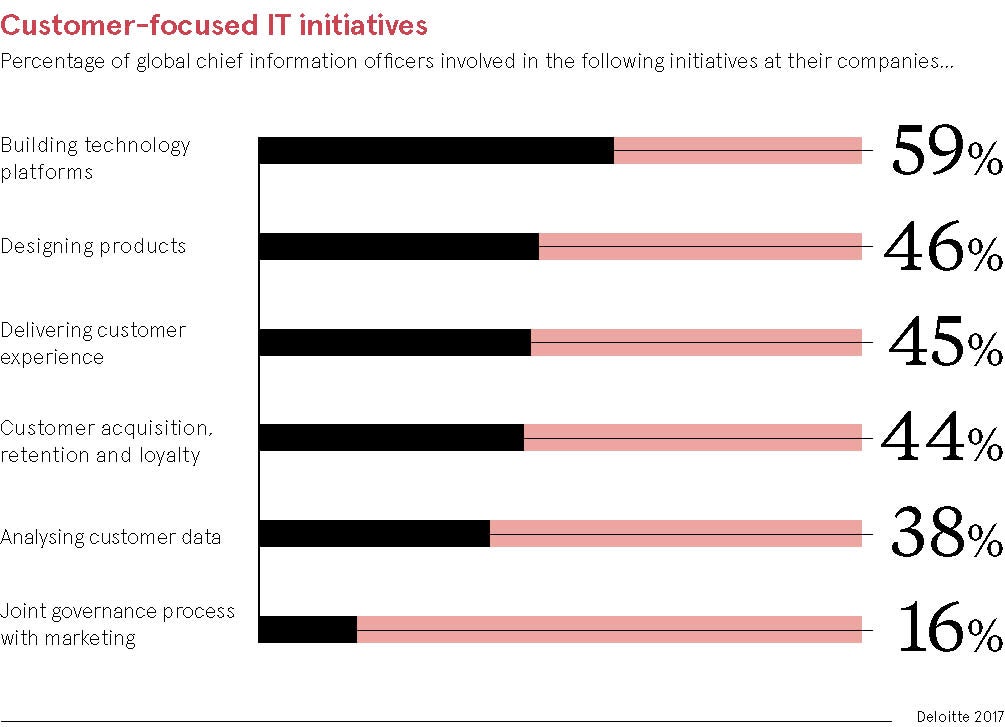While the focus is on newcomers entering industries and threatening the viability of traditional players, it is lack of customer centricity that poses the real threat to incumbents as the so-called disruptors are simply using digital technology to build an operation around the consumer. It is a realisation that is forcing larger companies to transform the way they do things, while a bigger picture is slowly emerging.
“People recognise that customer centricity is a driver for revenue growth, driving loyalty, retention and sales,” says Duncan Barnes, partner in consulting at Deloitte. “But it is also increasingly seen as a driver for cost-reduction. There used to be this misnomer that a better customer experience and a reduced cost to serve were in conflict, but people recognise now that dissatisfaction for customers is a source of cost for businesses.”
Business transformation means putting the customer at the heart of everything from product development to marketing
Customers demand not only value but also transparency, accessibility, convenience and personalisation. Dissatisfaction can extend from the product or service itself to the wider customer experience. Business transformation means putting the customer at the heart of everything from product development to marketing.
“The continual challenge in all customer-centric transformation is to be very close to your customers, and to test what you’re building and get regular feedback,” says Mr Barnes. “The best example is when businesses bring customers into the ideation process and help them to come up with new ideas for how to serve them better, making them part of the community for new idea generation and testing.”
Many established businesses struggle, not because they don’t recognise the need for change and the threat posed by more customer-centric startups, but because they are unable to implement digital transformation. It is not easy to achieve for large organisations, which are invariably hampered by legacy systems and an ingrained way of doing things.
Mr Barnes adds: “Big companies find it very hard to make significant changes quickly. Small companies are often more agile and are able to overtake them, so the challenge for big companies is how do they adopt the culture of a startup without throwing the baby out with the bath water?”
In the energy sector, increasing competition, evolving regulatory demands and changing customer behaviour has piled pressure on providers to transform their operations to stay relevant. Incumbents have turned to partnerships and acquisitions, enabling them to tap into technological innovation and act with greater speed and agility.

Centrica-owned British Gas was the first of the big six energy firms to move into the smart home market when it launched its connected home brand Hive in 2013. Two years later it acquired AlertMe, the technology platform that underpins Hive. Sudeep Maitra, global vice president of strategy for Centrica Connected Home, says: “The AlertMe platform gave us a very good and credible starting point in the connected home space, but we have since built on it for scale. We are close to one million customers now.”
The company has also used the platform to increase its range of connected home products, adding sensors and a camera, and integrating with Amazon Alexa and Google Home. “Acquiring the AlertMe platform has enabled us to give customers an end-to-end digital experience,” says Mr Maitra.
While npower and E.ON have also partnered with connected home specialists – Google-owned Nest and Greenwave respectively – one of the most recent acquisitions in the sector has been EDF’s purchase of engineering and technical services firm Imtech in 2017, enabling EDF to offer improved services, energy efficiency and low-carbon solutions.
As Richard Hughes, director of sales and marketing at EDF Energy, says: “No one company has all the expertise to meet the pace of change and sectors are rapidly converging. Our partnership with Imtech is a good example of where our combined skills and level of experience will give us a far greater capability and reach to respond to customers’ changing needs.”
Both Centrica and EDF attribute at least some of the success of their partnerships to adopting an agile methodology. “That is how we think and how we put the customer at the heart of our product development,” says Mr Maitra. “We test extensively with customers what kind of product they want and how they want to use it, and then we have iterative development, take it to market and keep improving iteratively.”
He says the culture has since permeated Centrica as a whole: “We are better at how we serve our customers, automating what we do and reacting on digital channels.”
Mr Hughes concedes that keeping pace with EDF’s more agile technology partners can be a challenge, but the company addresses this by working through proof of concepts at the start. “Not only to prove the idea or technology has legs, but also to demonstrate that we can work effectively together,” he says. “From here we can then look to formalise the relationship more effectively.”
It is not just the big six who are busy forging partnerships. Relative newcomers also see this as the way to stay ahead. Stephen Fitzpatrick, founder of Ovo, the energy supply company launched in 2009, says: “Partnerships have allowed us to diversify our offering and tap into new technologies and digital products.”
He cites Ovo’s partnership with electric vehicle charging point startup ubitricity and the acquisition of smart-grid company VCharge as examples. “We have been able to shift our offering from that of a core energy supplier to a truly integrated, technology-enabled energy services company,” says Mr Fitzpatrick.

